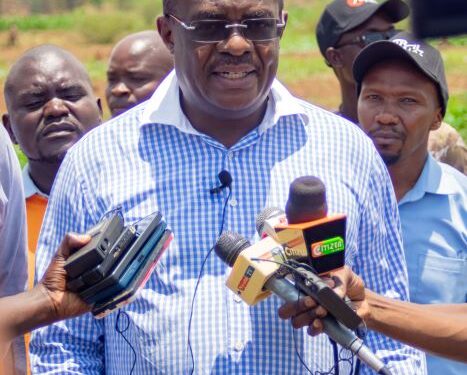Kenya is ramping up its fight against malaria with a multi-pronged strategy, even as a widening funding gap threatens progress. The government is leaning on private sector partnerships to bridge the shortfall, now estimated at Sh25 billion, with Busia County emerging as a testing ground for an aggressive intervention aimed at slashing malaria transmission rates.
Busia, which records the highest malaria prevalence in the country, six times the national average has launched the third phase of its Larval Source Management (LSM) initiative, backed by SC Johnson. The approach targets mosquito breeding sites using biolarvicides, an innovative vector control method deployed via drones.
“When we did the spraying in Busia covering about 17 hectares of breeding ground, we had a 95 percent reduction in the number of adult mosquitoes that could have caused infection,” said Dr. Willis Akhwale, a Special Advisor to the End Malaria Council (EMC).
The initiative marks a shift in malaria control efforts, which have traditionally relied on insecticide-treated nets (ITNs) and indoor residual spraying (IRS). Biolarvicides such as Bacillus thuringiensis israelensis (Bti) and Bacillus sphaericus specifically target mosquito larvae, preventing them from maturing into disease-carrying adults. Unlike chemical pesticides, these biological agents are WHO-certified and pose no harm to humans or animals.
“Biolarvicides are sprays that kill young mosquitoes before they become adults by targeting their intestines,” explained Arthur Odera, Busia County Deputy Governor and CECM Health & Sanitation.
The spraying effort, executed using drones capable of carrying 30 liters of larvicides per flight, has the potential to cover over 25 hectares in a single deployment—expanding access to hard-to-reach breeding grounds.
SC Johnson, the multinational behind household brands like Raid™, is deepening its malaria control investments in Kenya. The company has already injected over $10 million into malaria prevention initiatives, including spatial repellent research, community education, and health infrastructure support.
“What we are trying to do is see how we can start promoting local manufacturing of the biolarvicides, mosquito nets, and everything we are able to use in the fight against malaria,” said Isaac Maluki, a Member of the End Malaria Council.
Earlier this year, SC Johnson commissioned high-speed production lines at its Nairobi plant to manufacture Guardian™, a spatial repellent designed to curb mosquito populations. At full capacity, the company expects to produce up to 20 million units annually, with distribution prioritized for high-risk communities through public health channels.
Beyond vector control, SC Johnson has also invested in rehabilitating a health center in Malaba, a border town in Busia County, transforming it into a center of excellence for malaria prevention and treatment. The facility is expected to enhance access to care, particularly for cross-border communities that face higher exposure to malaria due to movement across endemic regions.
Despite these targeted interventions, Kenya’s malaria response is under financial strain. The country requires substantial funding to sustain and scale up its malaria strategy, which encompasses IRS, ITNs, vaccination, case management, and behavioral change campaigns.
“Remember, this is not the only strategy. The reason a lot of efforts are being put in Busia County is because in terms of transmission, the county has the highest transmission of malaria in Kenya,” said Dr. Akhwale.
Malaria remains one of Kenya’s most pressing public health challenges, accounting for 40 percent of outpatient visits in Busia and contributing to 2 percent of all deaths. While donor funding and public-private partnerships have sustained the fight, there is a growing urgency to mobilize local resources and attract new investment.
“To achieve the Kenya Malaria Strategy’s goal of reducing malaria incidence, shared strategies, resource mobilization, and collaboration are our most potent weapons in this fight,” said Chris Getonga, Chairman of EMC Kenya.












